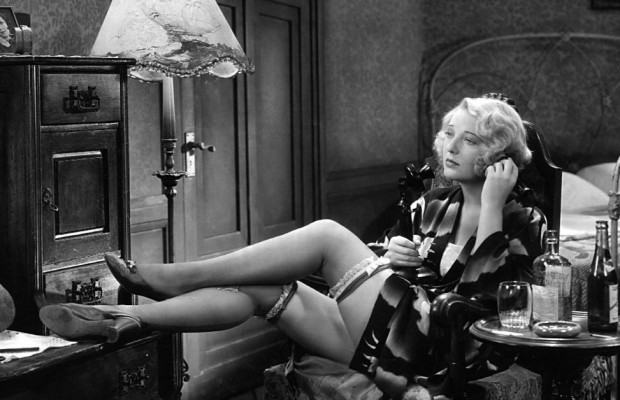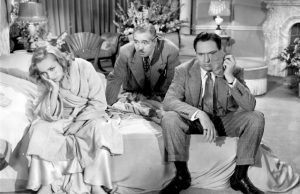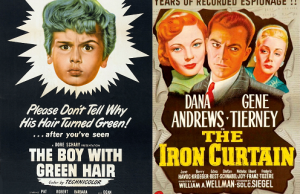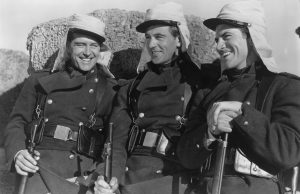Safe in Hell (1931)

Toronto Film Society presented Safe in Hell on Friday, May 10, 2013 as part of Season 66 May Festival: The Pre-Code Weekend.
I may be one of the few here who only became aware of Dorothy Mackaill when I saw her in the 1929 film His Captive Woman at Cinefest last March 2012. After that film, I wanted to see more of her and Safe in Hell sounded like a good film to start with. If I remember correctly, poor Dorothy is anything but safe and I don’t know if you’ve ever seen as many lecherous men in one room drooling over a our lovely heroine. Enjoy this somewhat creepy film.
Caren Feldman, May 10, 2013
A strong and well-planned exploitation campaign secured considerable advance and starting attention for ‘Safe in Hell’ at the Strand. And it’s needed. This is a talker that must have expert handling;  it isn’t the type to build by itself. If the New York lead is followed elsewhere, the film can get some money at the outset, but that it can sustain is in doubt.
it isn’t the type to build by itself. If the New York lead is followed elsewhere, the film can get some money at the outset, but that it can sustain is in doubt.
The ‘Not for Children’ slogan is the keynote of the New York campaign. That line gets equal billing in marquee lights with the title. Newspaper layouts were along similar lines for two or three days before the opening, with all matter warmly phrased.
Picture’s story is hardboiled and sordid. Too much so most of the time, which is ‘Safe in Hell’s’ chief deficiency. Dorothy Mackaill plays a bad lady all the way to the finish, when she reforms morally while on her way to the gallows. She’s a call girl in the opening sequence and by chance is sent for by her first betrayer. She throws a vase at him with apparently fatal results, a fire starts as she runs away, and the place burns down. A charred body found in the ruins is presumably that of her victim, so she sails away from New Orleans with her sailor sweetheart with the police not far behind.
The boy parks her on a tropical island whose white inhabitants are fugitives. They’re protected by the island’s lack of extradition laws. The couple are married there and the boy sails away after promising to return.
Miss Mackaill, as the island’s only white woman, is on the receiving end of the make from the other island gents, among whom are some of the worst looking characters ever dragged onto a picture set. When Piet, the guy she supposedly killed back in N.O., shows up, he doesn’t last long. She plugs him again, this time with a gun.
A sad and unsatisfactory finish is obviously an attempt to lend credence to an impossible yarn. It doesn’t help, for as long as the story is thoroughly unbelievable up to the finish, no ending could change that impression. Those who go for this sort of stuff won’t care for the exit.
Miss Mackaill had little chance to do anything but be tough in a self-defense way, but she manages to wade through it without stepping over the boundary and growing over-emotional. Aside from Ralf Harolde’s heavy and Don Cook’s hero, Morgan Wallace, Victor Varconi, Ivan Simpson, John Wray, G. Von Seyffertitz, Charles Middleton and Noble Johnson are called upon mainly to express lust in various ways. Harolde succeeds more than anyone else in convincing Nina Mae McKinney, with one song, and Clarence Muse are the colored comedy relief, but up against too much of a handicap in the form of a constantly depressing air of evil which prevails throughout the picture.
Director William Wellman seems to have probed the limit from the material at hand, this taking in both plot construction and manipulation of characters. The technical side, photographically and scenically, is also first rate.
VARIETY, Bige., December 22, 1931
“Safe in Hell” is another one of the prodigious number of obscure and now-forgotten plays that turned up so frequently as movie fodder in the early days of sound, the romantic and genteel ones going to RKO, and the gutsier ones to First National. So many of them had basically good little stories that still needed good directors and colorful casts to make anything out of them, that it’s really not  surprising that they lit no theatrical bonfires. Of course, they didn’t exactly turn the movie business upside down either, but they did contribute strong and off-beat stories which were often far meatier than those contrived by the contract studio writers.
surprising that they lit no theatrical bonfires. Of course, they didn’t exactly turn the movie business upside down either, but they did contribute strong and off-beat stories which were often far meatier than those contrived by the contract studio writers.
“Safe in Hell”, with its roots in “Sadie Thompson”, is a curious little film. The majority of it takes place in one basic set, which is solid and well designed to permit camera movement, but which inevitably betrays the theatrical origin. However, it never settles down to being just a photographed play. Occasionally Wellman rather overdoes the off-beat camera angles, but the camerawork on the whole is very pleasing. There are some extremely well-composed two shots of Cook and Mackaill, including one very tight one through wooden slats. And of course the theatrical flavor of the plot, characters and dialogue is flavorsome and enjoyable in itself.
Barely in one film have we ever seen so many unshaven and lecherous old rascals all lusting after “the only white woman on the island”. Morgan Wallace re-does his Marquis de Praille from “Orphans of the Storm”, though on an even baser level, and when he isn’t trying to seduce the heroine he’s making her (and us) a little nauseous by explaining why all the water has “wrigglers” in it! However, it’s all a shade too unpleasant to be really a “fun” movie, nor is it of sufficient importance to be taken really seriously. It’s one of those movies that really had no reason for having been made—yet from its startling and flaming opening title to its very effective and quite moving finale, it’s all quite expert and attention-holding. Like Everest, it’s there—and thus has to be seen, or at least made available for seeing. It fills us in a little more on Wellman, and perhaps that is all that it needs to do, although I don’t want to sell Dorothy Mackaill short. She’s a fine, warm and too often forgotten actress, and her performance here is quite remarkable, and the one element that gives “Safe in Hell” whatever integrity it has.
WILLIAM K. EVERSON, March 23, 1965
SAFE IN HELL, First National production and release. Directed by William Wellman. Adaptation and dialog by Joseph Jackson and Maude Fulton.
“Safe in Hell” is a little reminiscent of “The Unholy Garden,” with its tropic sanctuary where rogues of various nationalities live out their days in happy oblivion, safe from the long arm of extradition. The theme is a good deal sadder, a sort of melodramatization of all those sad songs about the women who will die rapturously for their men. The film opens to the music of “St. Louis wo-man…” It  closes with a view of the unhappy heroine disappearing among the palm trees to be throttled by the island executioner. She killed one man because she promised a new admirer that she would be good. The most accurate criticism, pro and con, was delivered by a couple in the adjoining seats. The young woman swept piteously and the young man reassured her:
closes with a view of the unhappy heroine disappearing among the palm trees to be throttled by the island executioner. She killed one man because she promised a new admirer that she would be good. The most accurate criticism, pro and con, was delivered by a couple in the adjoining seats. The young woman swept piteously and the young man reassured her:
“It’s only a motion picture.”
Gilda is presented as the sort of girl who feels neglected when she is not defending her honour. She burns down a New Orleans hotel in the first five minutes trying to be a good girl. When her sailor sweetheart spirits her away to the “safe in hell” locale, she has a more extensive field for proving her virtue.
Dorothy Mackaill and Don Cook are unhappy lovers. The fugitive murderers and swindlers are a rather amusing lot. Nina Mae McKinney, the too seldom seen temptress of “Hallelujah,” as a dark-skinned barmaid, is about the most entertaining item in the film.
NEW YORK TIMES, by Andre D. Sennwald, December 19, 1931
Notes complied by Caren Feldman










Leave a Reply